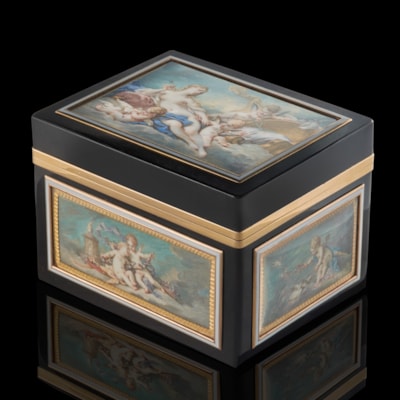A Major of the 53rd (Shropshire) Regiment of Foot, with gold lace and epaulettes, a frilled cravat, and his hair powdered en queue; circa 1810-1816
Watercolour on ivory
Gilt metal frame with blue silk reverse
Oval, 75mm (3in) high
SOLD
Emma Rutherford has suggested that Craig was a ‘grounded, empathetic, and relatable instructor…’, and some of this empathy is reflected in the way Craig has depicted this gentleman.[3] Though his identity remains unknown, his uniform is of the 53rd (Shropshire) Regiment of Foot. Elements of the officer’s uniform provide evidence of the date at which this portrait was painted. The star on the strap of his left epaulette was an element introduced in 1810; it indicates that the sitter was a Major. Therefore, the present work must have been painted after that date and before the significant changes to the style of British infantry uniform coats in circa 1816.
The 53rd (Shropshire) Regiment of Foot was one of only two regiments to have scarlet coats faced with red and the only one of the two whose officers had their coats embellished with gold-laced, square- ended loops worn in pairs. In 1803, a second battalion of the regiment was raised; it was sent to the Peninsular War (1808-14) in 1809. The first battalion, in existence since 1755, was stationed in India at the date of this miniature. There is no record of Craig travelling to India, so it is more likely that this major was of the second battalion.
We are grateful to Stephen Wood for his advice about the uniform in this portrait.
[1] See E. Rutherford, E. Smith (eds.), “Without Hands”: The Art of Sarah Biffin, Philip Mould & Company, 2022.
[2] Ibid., ill. p. 43.
[3] Ibid., p. 41.
Christie's, London, 12 July 1988, lot 203;
Collection of Dr. Erika Pohl-Ströher.

shipping notice
Worldwide shipping is included in all prices.
The Limner Company does not accept any responsibility for import duty, this is to be paid by the buyer.
Some stock items contain materials from endangered species which are governed by CITES regulations and will require a permit to export outside of Great Britain. If a certificate of export is required then this will be the responsibility of and paid for by the buyer .
you may also like














